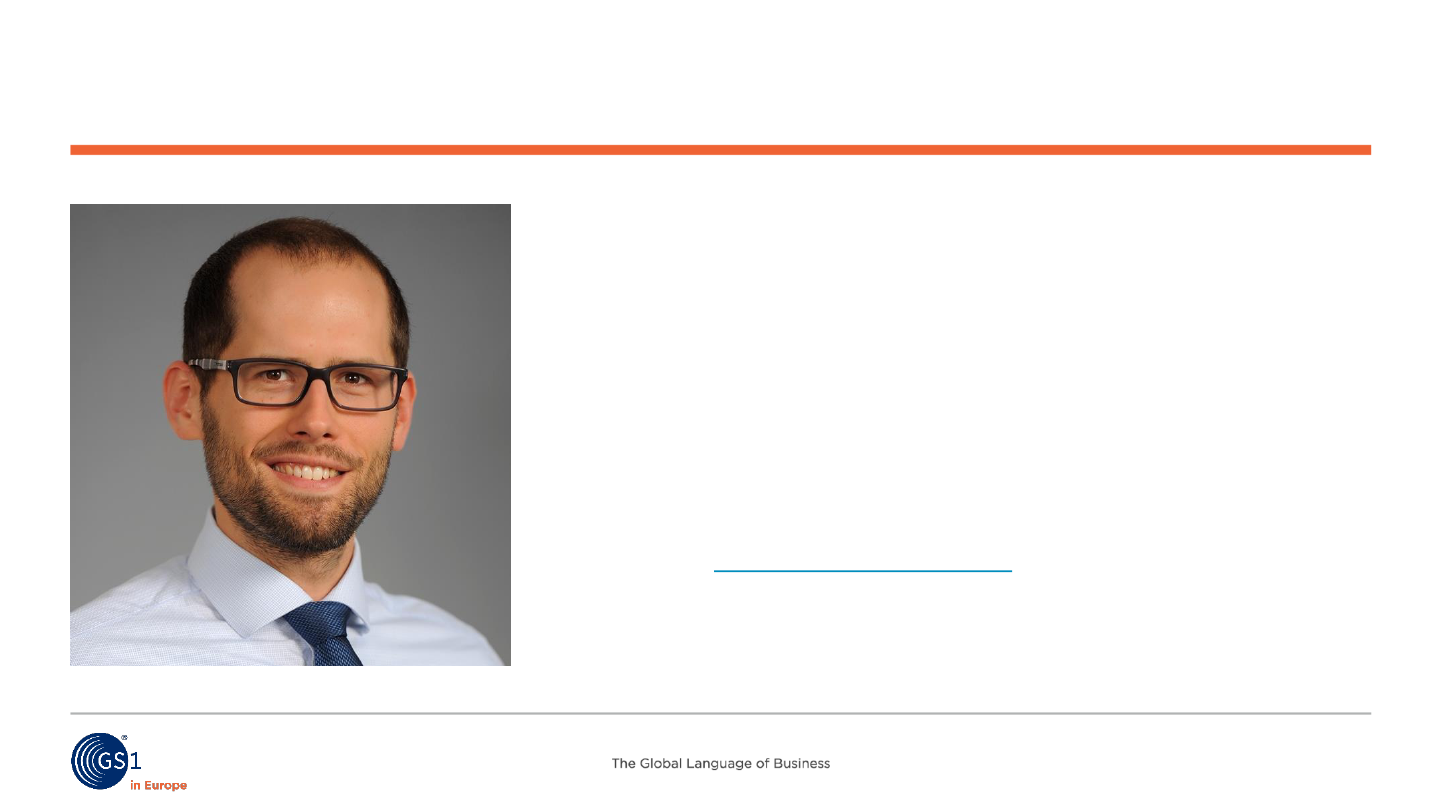
Data Excellence User Board & Global Data Model
How do we implement and govern the Global Data Model in Europe?
Jan Somers, Tomas Tluchor, Henk-Jan Timmerman, Markus Mueller, Mark van Eeghem,
Armand Schins, Christian Przybilla, Jean-Mark Klopfenstein, Laurent Seroux, Christian
Zaeske
3 July 2020

© GS1 in Europe 2020
Anti-Trust
• GS1 operates under the GS1 anti-trust caution. Strict compliance with anti-
trust laws is an always has been the policy of GS1.
• The best way to avoid problems is to remember that the purpose of the
committee is to enhance the ability of all industry members to compete more
efficiently.
• This means:
- There shall be no discussion of prices, allocation of customers, or products,
etc.
- If any participant believes the group is drifting toward impermissible
discussion, the topic shall be tabled until the opinion of counsel can be
obtained.
• The full anti-trust caution is available at www.gs1.org
2

© GS1 in Europe 2020
Agenda
• Introduction & ambition
• General update on the GS1 Global data model
• Implementation of GDM in European markets
BREAK – 5 MINUTES
• Governance in Europe (locally and regionally)
• Industry engagement in Europe
• Next steps and closing
3

© GS1 in Europe 2020
Audience: 231 people (tentative) accepted
4
6
95
50
34
46
Attendees
Associations
Brand owner
GS1
Retailer
Solution provider
• And… - Multinationals
- United States
- South Africa
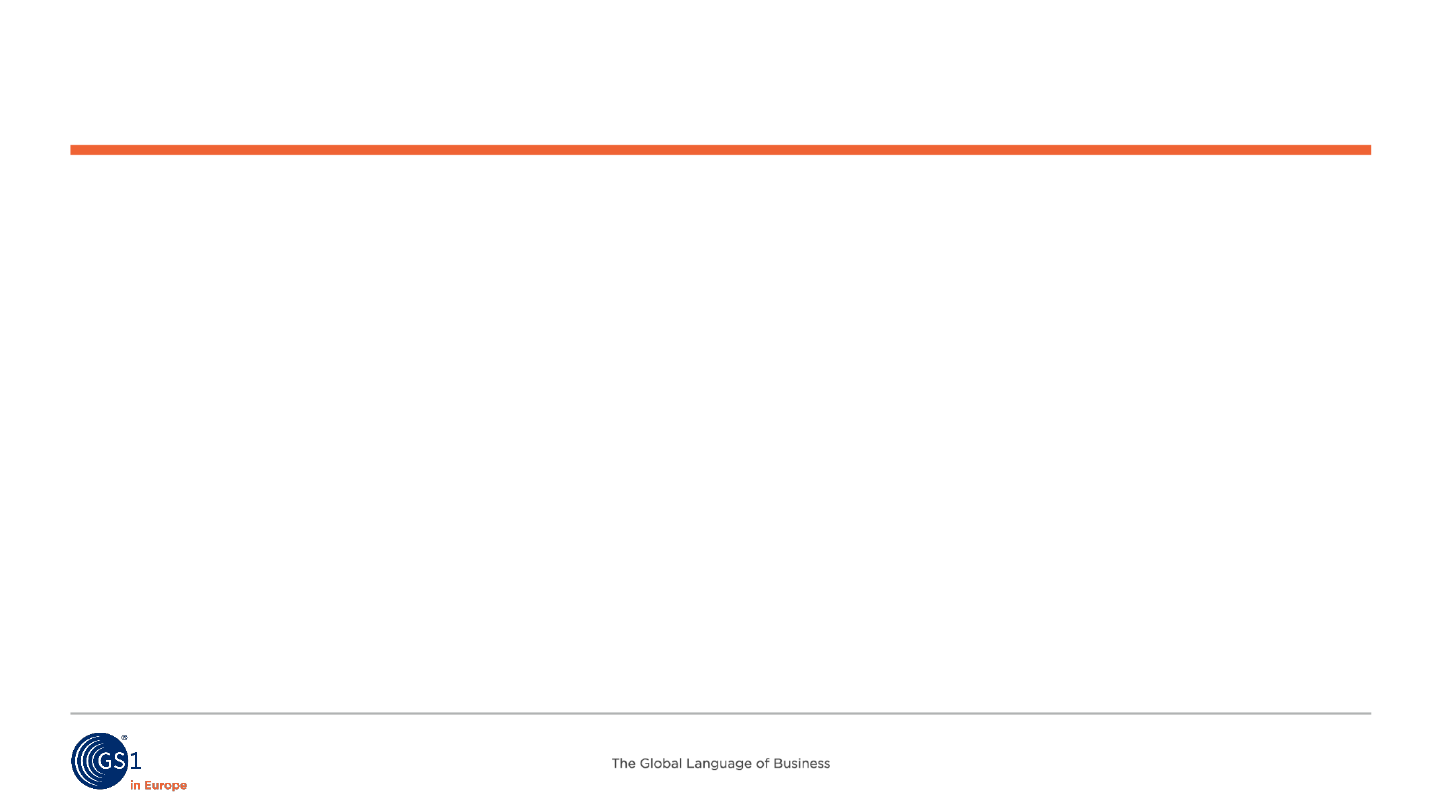
© GS1 in Europe 2020
Meeting etiquettes
• Big audience => tight agenda
• Meeting will be recorded
• Please mute yourself
• Questions through chat
- After each section limited time
- All questions will also be answered afterwards
• Thank you in advance for participating
5

© GS1 in Europe 2020
Jan Somers
CEO of GS1 Belgium & Luxembourg
Sponsor GS1 in Europe & Sponsor the GDM Worldwide
Introduction & Ambition
6

© GS1 in Europe 2020
No ambition, no plan, no progress
• We need to be ambitious to change the way we exchange data
• Why?
- Data exchange is difficult due to national data models and different usage of
attributes
- Every data recipient needs a data set or at national level
- Trade is no longer national, our way of data exchange is outdated
- We need a mind shift and another way of working
• What?
- GMD harmonises and simplifies the data we exchange, worldwide, regionally
• How?
- Get industry, and GS1 and CGF together and implement
9

© GS1 in Europe 2020
The GS1 Global Data Model
10
One product. One experience. Every
channel.
The GS1 Global Data Model helps leverage
product content for a seamless shopping
experience across every channel.
By simplifying and harmonising the exchange of product data
around the world, the GS1 Global Data Model standard
increases operational efficiency for brand owners and retailers
and improves data accuracy and completeness for consumers.

© GS1 in Europe 2020
The history of the Global Data Model
11
2018
2019
2020
Conception
Development
Implementation

© GS1 in Europe 2020
Ambition of Europe
• Help and stimulate change and mindset
• Help the industry to implement the GDM
in 49 GS1 Member organisations,
in consultation with the industry
- Implement global and regional layer
- Review local layer
• Grow the community
- Adding countries
- Adding industry users
• Review adoption in Europe
with specific governance
12
“With the GS1 Global
Data Model, we hope
to provide consistent
information to
consumers across
retailers, online
players and markets”

© GS1 in Europe 2020
General update on the GS1 Global Data Model
13

© GS1 in Europe 2020
Agenda General Update GS1 Global Data Model
• Introduction & ambition
• General update on the GS1 Global data model
- General update on the Global Data Model (Markus Mueller)
- GDM statistics & tooling (Mark van Eeghem)
- Nestlé pushing for Data Quality (Jean-Marc Klopfenstein)
- Questions
• Implementation of GDM in European markets
• Governance in Europe (locally and regionally)
• Industry engagement in Europe
• Next steps and closing
15

© GS1 in Europe 2020
Markus Mueller (Global Office)
General update on the Global Data Model
16

© GS1 2020
17
The GS1 Global Data Model
Standard is the set of
foundational data attributes
that are needed to list, order,
move, store and sell products

18
© GS1 2020The Global Language of Business
To improve the omnichannel consumer experience, brand owners and retailers
should consider what truly differentiates and what can be standardised
WEBSITE
▪ Product data is comprised of both foundational and
differentiated attributes
▪ Foundational attributes can be harmonised to
enable timely, accurate, and consistent data exchange
for brand owners and retailers
▪ Retailers and brand owners can shift focus to
designing differentiated consumer experiences
versus verifying data quality
▪ Harmonised data will also unlock new opportunities
through advanced analytics
Foundational data is non-competitive in the
digital and physical retail environment

19
© GS1 2019The Global Language of Business
Overall, the Global Data Model will enable improved consumer experience and
will reduce complexity by harmonising foundational data across the industry
Simplified and
Harmonised
Global Data Model
(GDM)
Increased
transparency and
seamless
omnichannel
experience
Faster, easier,
cheaper
management and
exchange of
foundational data
Improve consumer
experience
Increase business
partner efficiencies

20
© GS1 2020The Global Language of Business
GDM uses the concept of layers to identify product attributes required for data
exchange
Global core layer
▪ Comprised of attributes required across all product categories
Global category layer
▪ Comprised of attributes
1
required only for a specific product category
(i.e., FMCG Food, DIY…), applicable at a global level
Regional category layer
▪ Comprised of attributes
2
required only for a specific product
category, only for a specific region
Country layer
▪ Comprised of attributes
3
required for a specific product category, only
for a specific location within a region
1 These attributes are mandatory or optional depending on the product subcategory (e.g. “Storage temperature” is mandatory for “Meat” subcategory, while it’s not mandatory for “Canned shelf stable products” subcategory)
2 These attributes are mandatory or optional depending on region (e.g. “Allergen statement” is mandatory in North America region due to regulatory requirements, while it’s not mandatory in other regions)
3 These attributes are mandatory or optional depending on country (e.g. “Packaging Material Quantity” is mandatory in some countries, while it’s not mandatory in others)

© GS1 2020
Categories covered by the standard
Current release covers the following retail categories:
• FMCG Food & Near Food
• Alcoholic beverages
• Pet Food
• Tobacco
Planning horizon:
The GS1 Advisory Council has encouraged the GDM team to plan the GDM
development for Non-Food categories, e.g. Cosmetics or Apparel in alignment with
the new Marketplaces Advisory Team.
21
The term "near-food products" refers to
drugstore products (e.g. skin care
products), but also cleaning agents, etc.
So products that are not food, but are still
offered by supermarkets because they
represent everyday consumer goods.

22
© GS1 2020The Global Language of Business
Getting ready to implement the GS1 Global Data Model
More than 50% of CGF Data Coalition members are planning to
implement the Global Data Model across 10 countries in 2020/21!
1
Q3/Q4 2019
Pilots & business case
Creating the foundation
Q1/Q2 2020
GDM & ADB Standard
Fast ratification
Q2-Q4 2020
Implementation & adoption
Initiate & orchestrate GDM
implementation together
3
2
2

© GS1 in Europe 2020
Mark van Eeghem (Global Office)
GDM statistics & tooling
23

© GS1 in Europe 2020
Introducing Mark van Eeghem
• Mark van Eeghem
• GS1 Global Office
• Senior Manager Global Data Model
• Mark.v[email protected]g
24

© GS1 in Europe 2020
GDM Statistics – Distinct Attributes
25
Global
EU
NoAm
AU/NZ
Local*
Total
Food
86 48 51 11 17 175
Near
-
Food
67 43 45 6 13 141
Pet Food
61 43 41 6 51 170
Alcoholic
Beverages
76 34 38 9 33 160
Tobacco
56 21 22 4 58 143
* Local Attributes are currently not assigned to individual countries

© GS1 in Europe 2020
Interim GDM navigator
• An INTERIM tool (until July 2021)
• For Manufacturers, Retailers, MOs, DP, … involved in
implementing Global Data Model.
• Allows user to get a global, regional and local view on the
GDM.
• Contains GDSN Information (Technical Properties - VRs –
Code Lists – Code Values) linked to GDM.
• Search for information on attributes, categories, sub-
categories, regions, countries, validation rules, code lists,
code values and GPC Bricks.
• It allows users to compare GDM Models, and manage (and
save) product profiles using all this combined information.
• Webinar to follow (link will be posted)
26

© GS1 in Europe 2020
Interim GDM navigator
27

© GS1 in Europe 2020
Interim GDM navigator
28

© GS1 in Europe 2020
Interim GDM navigator
29

© GS1 in Europe 2020
Interim GDM navigator
30

© GS1 in Europe 2020
Interim GDM navigator
31

© GS1 in Europe 2020
Jean-Marc Klopfenstein, Nestlé
Nestlé pushing for Data Quality
32

09/07/2020 Nestlé Corporate Presentation
Jean-Marc
Klopfenstein
Master Data Lead
Active within GS1 since 2015

Nestlé at a glance
▪ CHF 92.6 Bio in sales in 2019
▪ 291 000 employees in over 187
countries
▪ Over 2 000 brands
Over 1 billion Nestlé products sold every day

Data Quality is considered as high when it fits intended usage in Business Flows
• Complete - Available
• Accurate - Right First Time
• Conforming - Aligned to business rules, e.g.
industry Standards
• Consistent – Aligned automatically across Flows &
IT platforms, internally and externally
• Timely - Valid for defined time period, not obsolete
• Not Duplicated - Reliable
Root causes of Data Quality Issues include:
• Knowledge (e.g. Measure of physical product
incorrect or not aligned with external standards)
• Lack of definitions result in inconsistent, non-
conforming and/or inaccurate data
• Incorrect usage of Master Data within Flows/
Transactional data
• Industry has recognized the criticality of data
quality, using common standards, among others:
• Verified-By-GS1
• Global Data Model
• Digitalization Journey requests solid and accurate
data
Impact of non-quality
• Direct Costs (e.g. Fines from retailers)
• Indirect costs (e.g. rework, wrong decisions)
• TRUST
High Data Quality means data is… Why we have an opportunity NOW…

1. Define &
Measure
2. First-Time-Right
Data Entry
3. Automate
The virtuous circle to improve data quality
9 July, 202036
1. Measure
Monitor through business validation rules
2. First-Time-Right
when needed/possible, update
data entry screens to enforce
data quality at source
3. Automation
Automate data input leveraging business
validation rules
• Pre-population and validation
• Automatic creation

With the support of GS1, we can make a difference… TOGETHER
• Complete - Available
• Accurate - Right First Time
• Conforming - Aligned to business rules, e.g.
industry Standards
• Consistent – Aligned automatically across Flows &
IT platforms, internally and externally
• Timely - Valid for defined time period, not obsolete
• Not Duplicated - Reliable
Root causes of Data Quality Issues include:
• Knowledge (e.g. Measure of physical product
incorrect or not aligned with external standards)
• Lack of definitions result in inconsistent, non-
conforming and/or inaccurate data
• Incorrect usage of Master Data within Flows/
Transactional data
• Industry has recognized the criticality of data
quality, using common standards,
among others:
• Verified-By-GS1
• Global Data Model
• Digitalization Journey requests solid and accurate
data
Impact of non-quality
• Direct Costs (e.g. Fines from retailers)
• Indirect costs (e.g. rework, wrong decisions)
• TRUST
High Data Quality means data is… Why we have an opportunity NOW…

© GS1 in Europe 2020
Implementation of GDM in European markets
38

© GS1 in Europe 2020
Agenda Implementation of GDM in EU markets
• Introduction & ambition
• General update on the GS1 Global data model
• Implementation of GDM in European markets
- How to implement (Tomáš Tlučhoř)
- An example of an implementation plan (Jan Somers)
- Update on European markets (Henk-Jan Timmerman)
- Questions
• Governance in Europe (locally and regionally)
• Industry engagement in Europe
• Next steps and closing
39

© GS1 in Europe 2020
Tomáš Tlučhoř, GS1 Czech republic / GS1 in Europe / GS1 Global Office
How to implement the Global Data Model
40
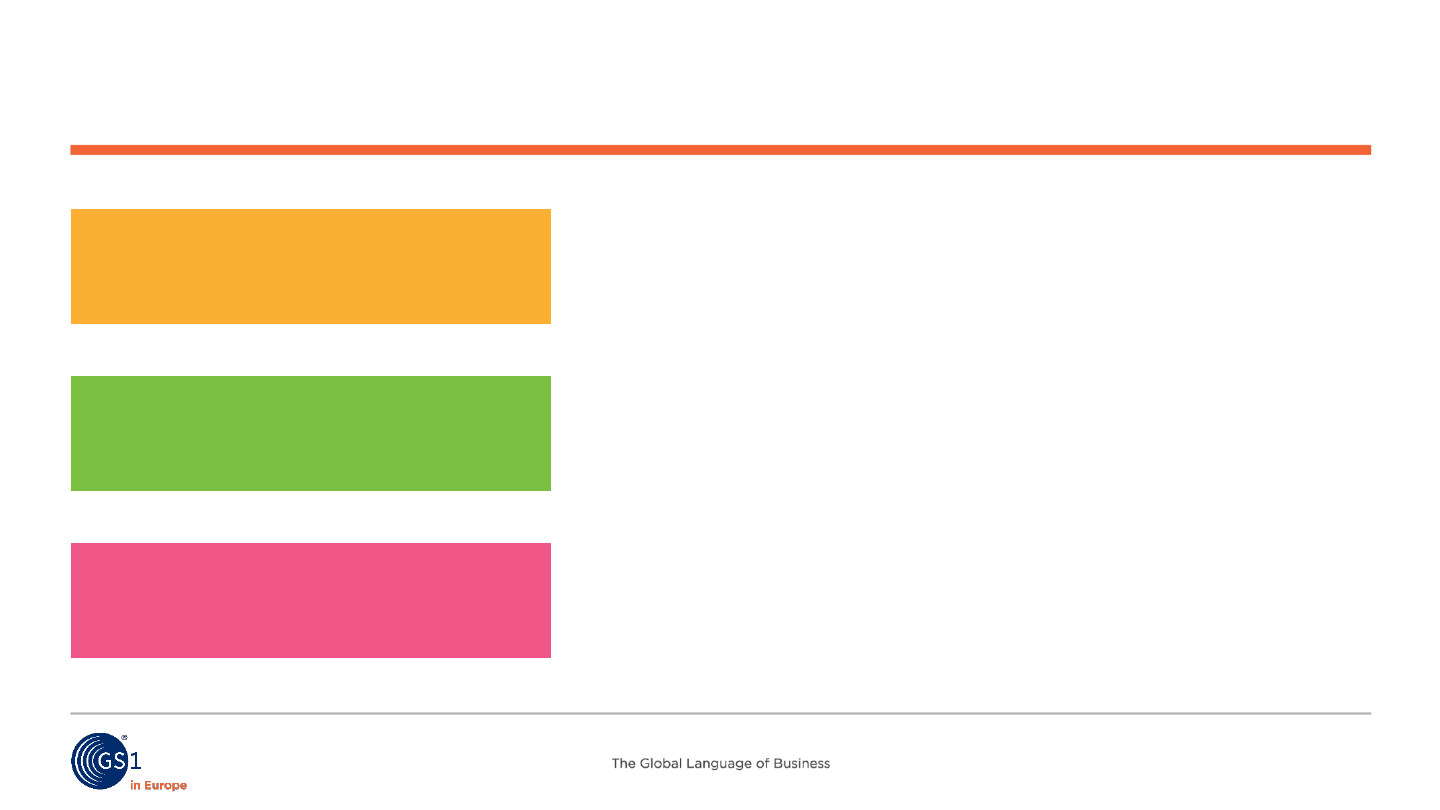
© GS1 in Europe 2020
GDSN already
implemented
Different strategies for different markets
42
• Get ambassadors – e.g. CGF Data Coalition Companies
• Introduce GDM at your GDSN working group
• Start with the attribute gap analysis
Starting with GDSN
• Get ambassadors – e.g. CGF Data Coalition Companies
• Establish GDSN working group
• Use GDM as your data model
No GDSN implementation
• Do a research – is there demand in your market? Are
there any potential ambassadors?
• What about tooling?
• Is it feasible for my market to be an early adopter?

© GS1 in Europe 2020
Implementing GDM attributes
43
Core
Include all core attributes in
your data model
Include all global attributes
in data model for your categories
Include all European
attributes in data model for
your categories
Try to limit number of local attributes in your data model
to a minimum
No demand for some
Global and Regional
attributes in your
market?
• Explore why
• Report back to
GDM
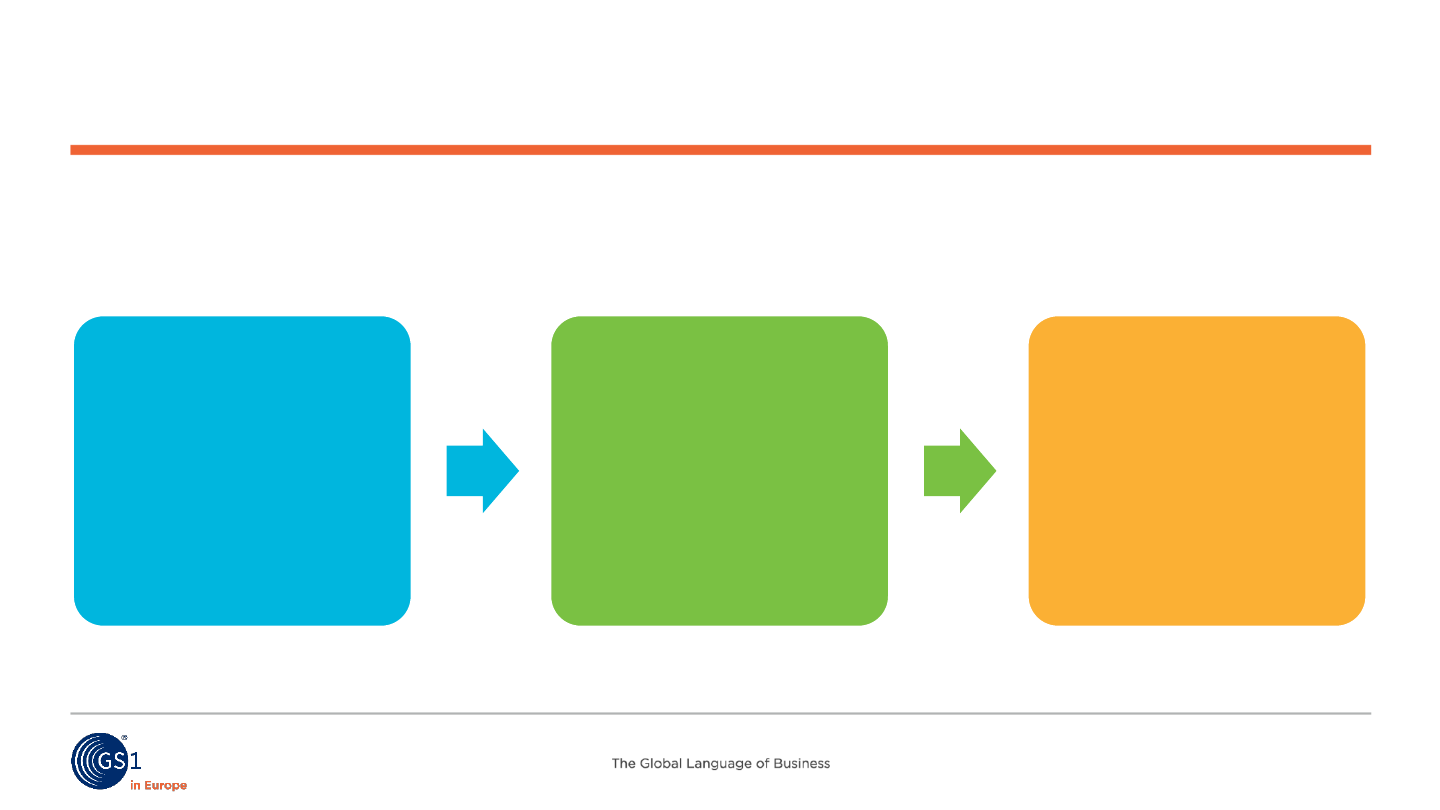
© GS1 in Europe 2020
Compare GDM attributes with attributes from your model
Attribute Gap Analysis
44
Analyse
• Use BMS IDs
• Tool available
• MO should do
the work
Present
• Missing
attributes
• Local attributes
• Group it (e.g.
B2C, taxes …)
Change
• Get inspired
• Clean it up
• Migrate
• Report back
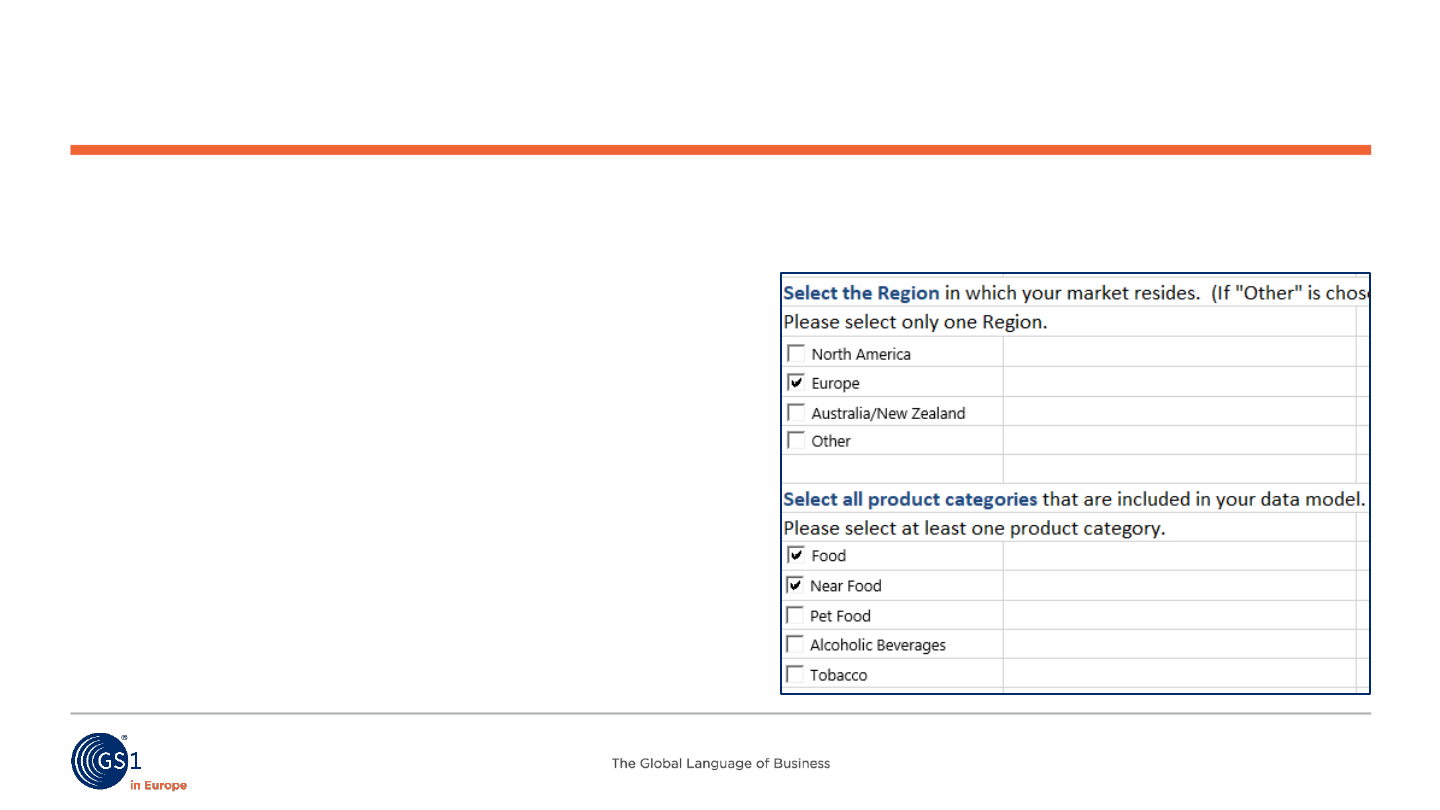
© GS1 in Europe 2020
Attribute analysis tool
• Excel tool will be provided soon
• Answers 2 main questions:
- What attributes are missing?
- What attributes are local, out of
scope or even proposed for
removal?
• All you need is list of your BMS IDs
45
Step 1: make your selection

© GS1 in Europe 2020
Attribute analysis tool – local data model
46

© GS1 in Europe 2020
Attribute analysis tool – list of gaps
47

© GS1 in Europe 2020
There is more than attributes
48
Attribute definitions
• Make sure your local validation
rules are not in conflict with Global
Data Model.
• Some conditions of conditionally
mandatory attributes might be
different from current local data
models.
• Work in progress
• Dividing codes into Global, Regional
and Local layers to „highlight“
important codes.
• Better names and definitions where
Global/Regional codes are not clear.
• Attribute Definitions for Business
- use these business friendly names
and definitions for GDM attributes.
• There might be some changes – e.g.
startAvailabilityDateTime:
- GDSN Definition: The date (CCYY-
MM-DDTHH:MM:SS) from which
the trade item becomes available
from the supplier, including
seasonal or temporary trade item
and services.
- ADB definition: The date/time the
product is first available to ship
from the seller or the service is
available.
Code lists
Conditions and Validation
rules

© GS1 in Europe 2020
Implement and maintain
Implement
• Agree on changes to your data model
• Provide documentation and training to
your community
• Agree on the timeline
• Include necessary changes to your
release schedule in an efficient way
• Learn from others – see an example
from BENELUX
Maintain
• Connect your local working group to the
Regional GDM governance.
• Report any issues you encounter when
implementing and using GDM.
• Follow and implement changes in the
GDM.
• Share your local layer.
49

© GS1 in Europe 2020
Jan Somers, GS1 Belgium & Luxembourg
Implementation in the Benelux, an update
50

© GS1 Belgium & Luxembourg 2015
Global Data Model – Gap analysis
• Result of gap analysis ➔ Global Data Model vs. BENELUX data model = 106 differences
• Type of differences :
o New attributes that are not in the Benelux data model
o Attributes that will be removed and will no longer exist/are not included in GDM
o Difference between local fields and mandatory/conditional fields
o Different conditions for making an attribute mandatory
o Difference between optional, conditional or mandatory fields
o Change in definitions (broadening the conditions for the use of an attribute)
o Difference between BELU, NL and GDM
• Local stakeholders impact analysis
meeting for BELUX : 8
th
of July
51

© GS1 Belgium & Luxembourg 2015
Global Data Model – Implementation & timing
52
Timing Planning
April – May 2020
Gap
analysis on the attributes
July 2020
First
draft version of Benelux data model
July – September 2020
Impact analysis based on first draft version
→
Done by GS1 + members of Maintenance Group, Data Committee and
Onderhoudsgroep
June – September 2020
Defining the code lists by GDM team GS1
October 2020
Definitive data model (incl. code lists) will be established, based on the results
of the impact analysis
October 2020
Defining timing of implementation, with three options:
1. Full introduction in February 2021
2. Partial introduction in February 2021
3. GDM introduction later than February 2021
February 2021
Implementation (full or partial) release of data model
→
Data will be mapped as much as possible
After February 2021
Data will be completed by suppliers where necessary, timing needed still needs
to be determined

© GS1 in Europe 2020
Henk-Jan Timmerman, GS1 in Europe
An update on implementation in Europe
53
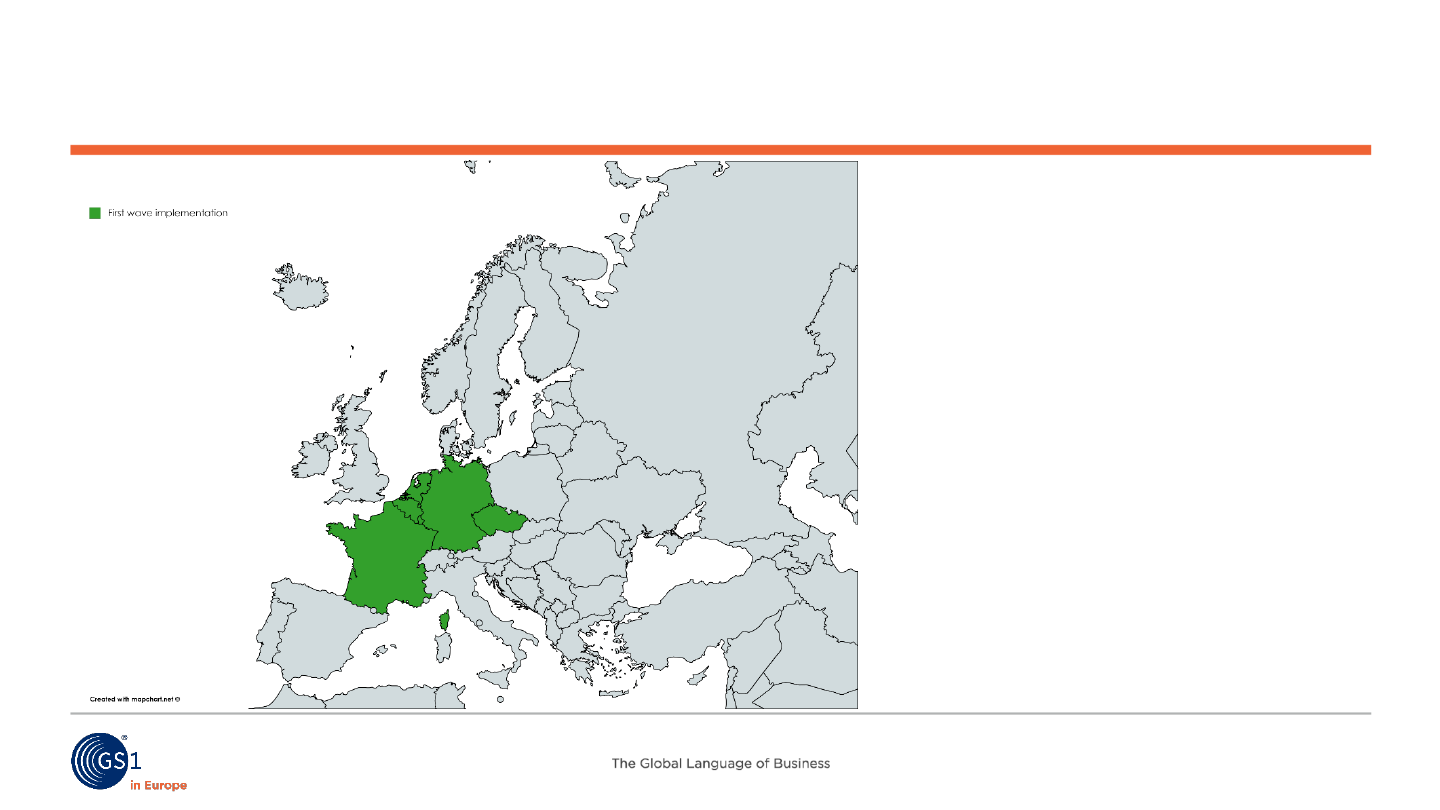
© GS1 in Europe 2020
Implementation in Europe – a prediction
54
Implementation started
(gap analysis):
• GS1 Belgium &
Luxembourg
• GS1 Czech Republic
• GS1 France
• GS1 Germany
• GS1 Netherlands

© GS1 in Europe 2020
Implementation in Europe – a prediction
55
Intention to implement
(through industry or
MO):
• GS1 Austria
• GS1 Denmark
• GS1 Sweden
• GS1 Switzerland

© GS1 in Europe 2020
Implementation in Europe – a prediction
56
Target markets prioritised
by industry or first
signals of interest for
implementation:
• GS1 Spain
• GS1 UK
• GS1 Poland
• GS1 Romania
• GS1 Turkey

© GS1 in Europe 2020
Governance in Europe (locally and regionally)
57

© GS1 in Europe 2020
Agenda Governance Global Data Model
• Introduction & ambition
• General update on the GS1 Global data model
• Implementation of GDM in European markets
• Governance in Europe (locally and regionally)
- Ahold Delhaize & Governance (Armand Schins)
- How is GS1 Germany organised on data? (Christian Przybilla)
- Setup of regional governance (Henk-Jan Timmerman)
• Industry engagement in Europe
• Next steps and closing
58

© GS1 in Europe 2020
Armand Schins, Ahold Delhaize
Introduction on Governance
59

© GS1 in Europe 2020
Introducing Armand Schins
• Armand Schins
• Ahold Delhaize
• Sr. Manager Data Quality &
Governance, AH Group (Albert Heijn,
Etos & Gall&Gall)
• Active within GS1 groups since 2004
60

© GS1 2019
61
One of the world’s largest food retail groups

© GS1 2019
Governance and GS1 representations
62
Global
Regio
nal
National

© GS1 in Europe 2020
Ahold Delhaize & GDM
Why we support GDM?
• Data Quality
• Data Efficiency
How we manage GDM?
• Jeffrey Cree (USA) & Armand
Schins (EU) participate &
coordinate on global & regional
level
• GS1 facilitates on all levels
• Implementation planning: 2021
63
IT Tools
• GDSN datapool:
- 1WorldSync (USA&BE)
- GS1DAS (NL)
- n.a. -> Excel (CR)
• PIM:
- Stibo-STEP (USA&NL)
- SRC-PIM (NL)
- SAP (BE)
- ERP Gold (CR)

© GS1 in Europe 2020
European business drives maintenance
• Data exchange is between business partners
- Business is in lead. Also for governance
• Active participation from all!
• Business should chair the maintenance team
- GS1 and solution providers are facilitating
• Need for speed!
- Connect on local level:
• Start gap analysis + Reduce local layers
- On regional level:
• Insight in local layers => Reduce or upgrade attributes
64

© GS1 in Europe 2020
Henk-Jan Timmerman, GS1 in Europe
The three layers of European governance
65

© GS1 in Europe 2020
Regional maintenance – GS1 in Europe
• Responsible: ongoing
maintenance of the Global
Layer
• Focus: business need of the
overall global model
• Responsible: ongoing
maintenance of the Regional
Layer
• Focus: business need of a
specific region, ex: Europe
• Responsible: ongoing
maintenance of the Local
Layer of a specific target
market
• Focus: business need of a
specific country, ex: Germany

© GS1 in Europe 2020
Strategic level Steering committee
67
Mission
Tasks
Participants
Industry:
• Select members
GS1 in Europe:
• Jan Somers: Sponsor
• Henk-Jan Timmerman
• Tomáš Tlučhoř
• Deciding on projects and scope per year
• Managing overall strategy and workplan
• Monitoring the implementation of GDM
Guide the data community within Europe on several
topics, such as data exchange and data quality.

© GS1 in Europe 2020
Tactical level Maintenance team
Maintenance of the regional layer of the GDM (all
components) and ensure the availability of harmonised
guidelines through active stakeholders managament
68
Mission
Tasks
Participants
Industry: Call for participation
• GS1 in Europe:
• Jan Schimmel (GS1 Netherlands)
• GS1 MO participants
• Maintaining regional layer, challenging local layer
• Monitoring the implementation of the GDM
• Reviewing of EU Regulations
• Finalise and approve harmonised guidelines
• Voting through GSMP process

© GS1 in Europe 2020
Tactical level Maintenance team
69
GSMP
Active in
Europe
Inclusive
4 releases
All target
markets
Code of
conduct

© GS1 in Europe 2020
Operational level B2B2C Working Group
Solve and harmonise technical questions that are raised
within countries
70
Mission
Tasks
Participants
GS1 only:
• Coordinator: Tomáš Tlučhoř
• GS1 MO participants
• Work on meeting EU Regulations requirements
• Technical proposals on migrations, validation rules
• Updates in the guidelines
• MO planned projects updates, any MO updates
• Quarterly reporting on regional layer to global office

© GS1 in Europe 2020
Christian Przybilla, GS1 Germany
How is Germany currently organised?
71

© GS1 in Europe 2020
GS1 Germany - Who is doing what and how?
73
GS1 Germany Handbook
for all governance + working groups:
- General rules for the decision making process
• Prerequisits for membership
• Voting rights and rules
- Description for every group
• Objective
• Scope
• Tasks
• Composition (50% supplier / 50% retail)

© GS1 in Europe 2020
How is GS1 Germany organised in general?
74
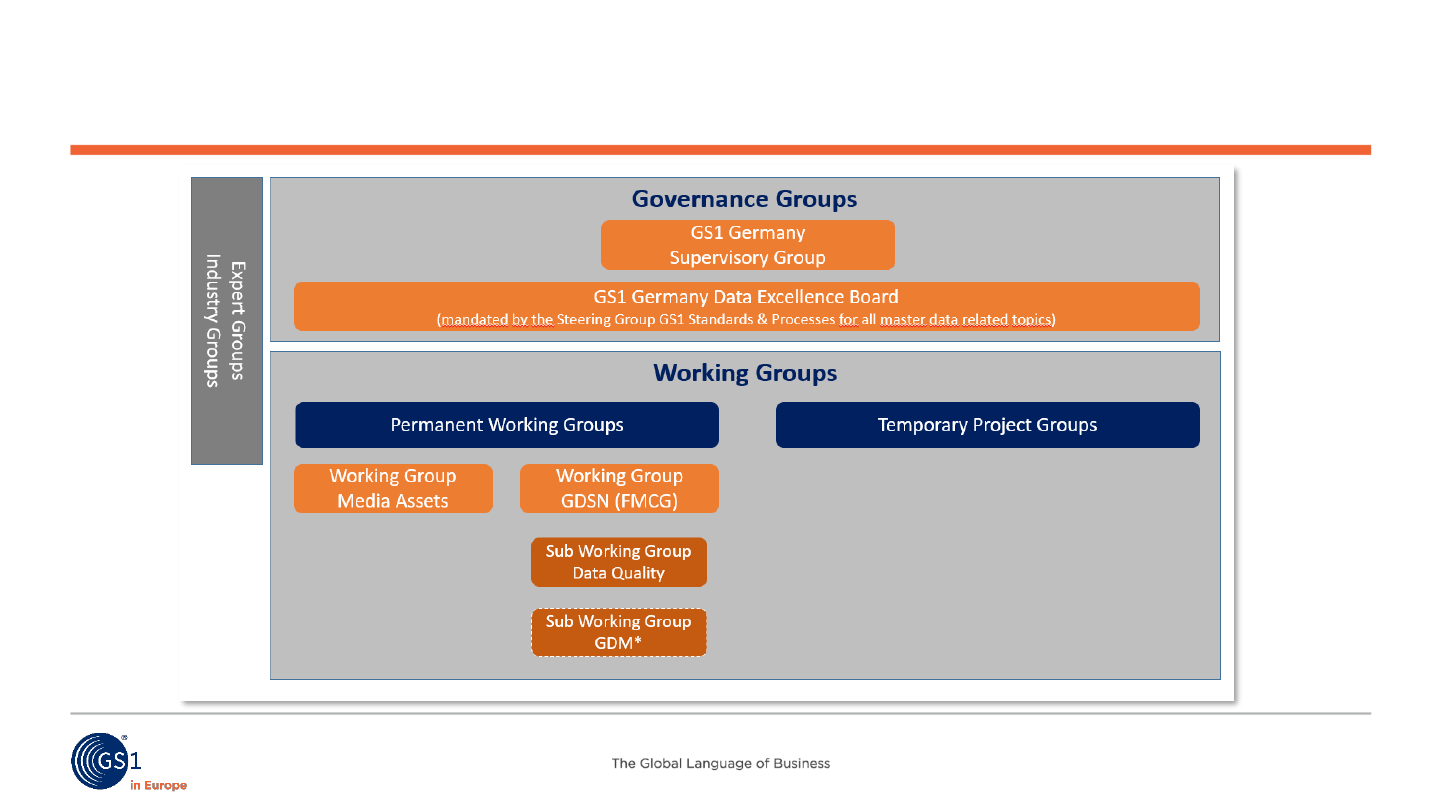
© GS1 in Europe 2020
How is GS1 Germany organised on data?
75
*intended positioning of national / local GDM group in Germany

© GS1 in Europe 2020
From the German perspective to be worked in the
near future
• GS1 Germany Data Excellence Board officially endorsed GDM in May 2020
• General committment to support work on:
- Build up the required governance (national/European/global)
- Document use of GDM attributes in national GDSN profile
- Learn and exchange experiences from pilots in real practice
- Start appropriate harmonisation efforts
(based on existing attribute differences in local/regional layers)
76

© GS1 in Europe 2020
Implementation of GDM in European markets
77

© GS1 in Europe 2020
Agenda Industry engagement Global Data Model
• Introduction & ambition
• General update on the GS1 Global data model
• Implementation of GDM in European markets
• Governance in Europe (locally and regionally)
• Industry engagement in Europe
- How will P&G drive implementation? (Laurent Seroux)
- Metro & local implementations? (Christian Zaeske)
• Next steps and closing
78

© GS1 in Europe 2020
Laurent Seroux, P&G
How will P&G drive implementation?
79

© GS1 in Europe 2020
Introducing Laurent Seroux
• Laurent Seroux
• Procter and Gamble
• Global Master Data Director
• Active with GS1 groups since 2016,
DE board member.
80

© GS1 2020
Serving
Consumer with
100% Accurate
Product
Information
81

© GS1 2020
82
SKIN &
PERSONAL CARE
ORAL CARE
FAMILY CARE
PERSONAL
HEALTH CARE
HAIR CARE
FEMININE CARE
BABY CARE
FABRIC CARE
GROOMING
HOME CARE
A Strong Portfolio in 10 Categories
Countries
of Operations
~70
Countries
Where Our
Brands are Sold
180+
Fiscal
2019 Net Sales
$67.7
Billion

© GS1 2020
Organisations will need to invest in the right people,
processes, and technology
PROCESSES
GDM will require…
PEOPLETECH
1
Gap analysis to identify
missing or different
attributes to support new
model
2
Changes in current systems:
external interfaces, product
data systems, and operational
systems
1
3
Data cleansing and
adaptation for existing
GTINs
5
Training for changes due to
GDM across business
processes (e.g., for new
product data processes)
1 Any product data related transformations (broader than GDM scope) will need to align with GDM to ensure full impact
2 Not a one-time activity, therefore captured in calculator under changes to operational efficiencies (pink section)
4
Changes to business process
to capture new required
attributes
2

© GS1 in Europe 2020
How will P&G drive adoption in Europe
• Internal
• Primary focus on GDSN countries and retailers
• Depth analysis of current P&G publication models and identification of gaps vs
the GDM attribute by attribute (DE completed).
- Technical and Functional assessment of gaps
- Inclusion of the GDM standard in new PIM
• Deploy the concept to Country leadership and Sales teams to create
awareness and be ready for Retailers demand to engage
• External
• P&G representatives in GS1 MO’s to influence MO’s and Data Pools
endorsement.
84

© GS1 in Europe 2020
Christian Zaeske, Metro
Metro & local implementations
85

© GS1 in Europe 2020
Introducing Christian Zaeske
• Christian Zaeske
•
• Global Head of Master Data
Management
• Member of GS1 Data Excellence Board
• Retail Co-Chair of Global Data Model
• Active within GS1 groups since 2006
86
• Photo

© GS1 in Europe 2020
AT A GLANCE
87
OUR PORTFOLIO
678
locations
In 34
countries
97,606
employees
2
AT A GLANCE
Group sales
€27,082 million
EBITDA
1
€1,021 million
1
EBITDA excluding earnings contributions from real estate transactions.
2
Headcount as of closing date 30 September 2019. As of: 30 September 2019.
678
locations
In 34
countries
97,606
employees
2
Group sales
€27,082 million
EBITDA
1
€1,021 million
1
EBITDA excluding earnings contributions from real estate transactions.
2
Headcount as of closing date 30 September 2019. As of: 30 September 2019.

© GS1 in Europe 2020
METROs GS1 in Europe presence in 21 countries
EUROPEAN METRO COUNTRIES
Austria
Belgium
France
Germany
Italy
Netherlands
Portugal
Spain
Bulgaria
Croatia
Czech Rep.
Hungary
Kazakhstan
Moldova
Poland
Romania
Russia
Serbia
Slovakia
Turkey
Ukraine
12
16
97
38
6
50
17
10
37
11
9
13
13
6
3
30
30
89
9
6
33
31
As of 30 September 2017.
• 2.000-5.000 suppliers per country
• 30.000 – 250.000 SKUs per country
• Cash & Carry, FSD, Franchise, Retail
+ Product Online Visibility
+ Web Shops & Long Tail
+ Marketplace
+ Digital Services

© GS1 in Europe 2020
89
Driving GDM market adoption by
community enablement
• Inform
• Initialize national GDM project
• Onboard industry
• Setup local GDM maintenance group
• Educate & Train
• Integrate national layer – local attributes to GDM
• Setup KPIs and reporting
• Start operational use of common data model based on GDM
• Announce local GDM maintenance group members representing
market within regional GDM maintenance group
• Collect feedback and identify improvement needs

© GS1 in Europe 2020
GDM 1st. country community implementation
90
GDM
Global
Layers
+ GDM
Regional
Layer
Europe
+GDM
Local
Layer
National
METRO
Bilateral
Attributes
Total
86 92 286 0 464
The German community decided to go live with the
Global Data Model in August 2020 for the German market

© GS1 in Europe 2020
• GDM in Europe METRO country implementations
91
1 2 3 4
GDM Global
layers
+ GDM
Regional
layer
+GDM local layer national
+GDM
local
layer
bilateral
Attributes
sum
DE x EU national datamodel integrated to GDM - =1+2+3
BE x EU national datamodel to be integrated to GDM - =1+2+3
CZ x EU national datamodel to be integrated to GDM - =1+2+3
FR x EU national datamodel to be integrated to GDM - =1+2+3
IT x EU national datamodel to be integrated to GDM - =1+2+3
NL x EU national datamodel to be integrated to GDM - =1+2+3
TR x EU national datamodel to be integrated to GDM - =1+2+3
AT x EU national datamodel to be integrated to GDM - =1+2+3
ES x EU national datamodel to be integrated to GDM - =1+2+3
PL x EU national datamodel to be integrated to GDM - =1+2+3
PT x EU no national datamodel* X** =1+2+4
HU x EU no national datamodel* X** =1+2+4
HR x EU no national datamodel* x** =1+2+4
RO x EU no national datamodel* x** =1+2+4
RS x EU no national datamodel* x** =1+2+4
RU x EU no national datamodel* x** =1+2+4
SK x EU no national datamodel* x** =1+2+4
UA x EU no national datamodel* x** =1+2+4
BG x EU no national datamodel* x** =1+2+4
KZ x EU no national datamodel* x** =1+2+4
MD x EU no national datamodel* x** =1+2+4
* to be confirmed by national GS1 MO ** to be defined if after * is confired
• clarification
local layer
• METRO bilateral
local layer in case
of missing national
community layer
• Question to the
European user
community:
Are you interested
to define a common
default local layer ?
(for all markets not having a
national model)
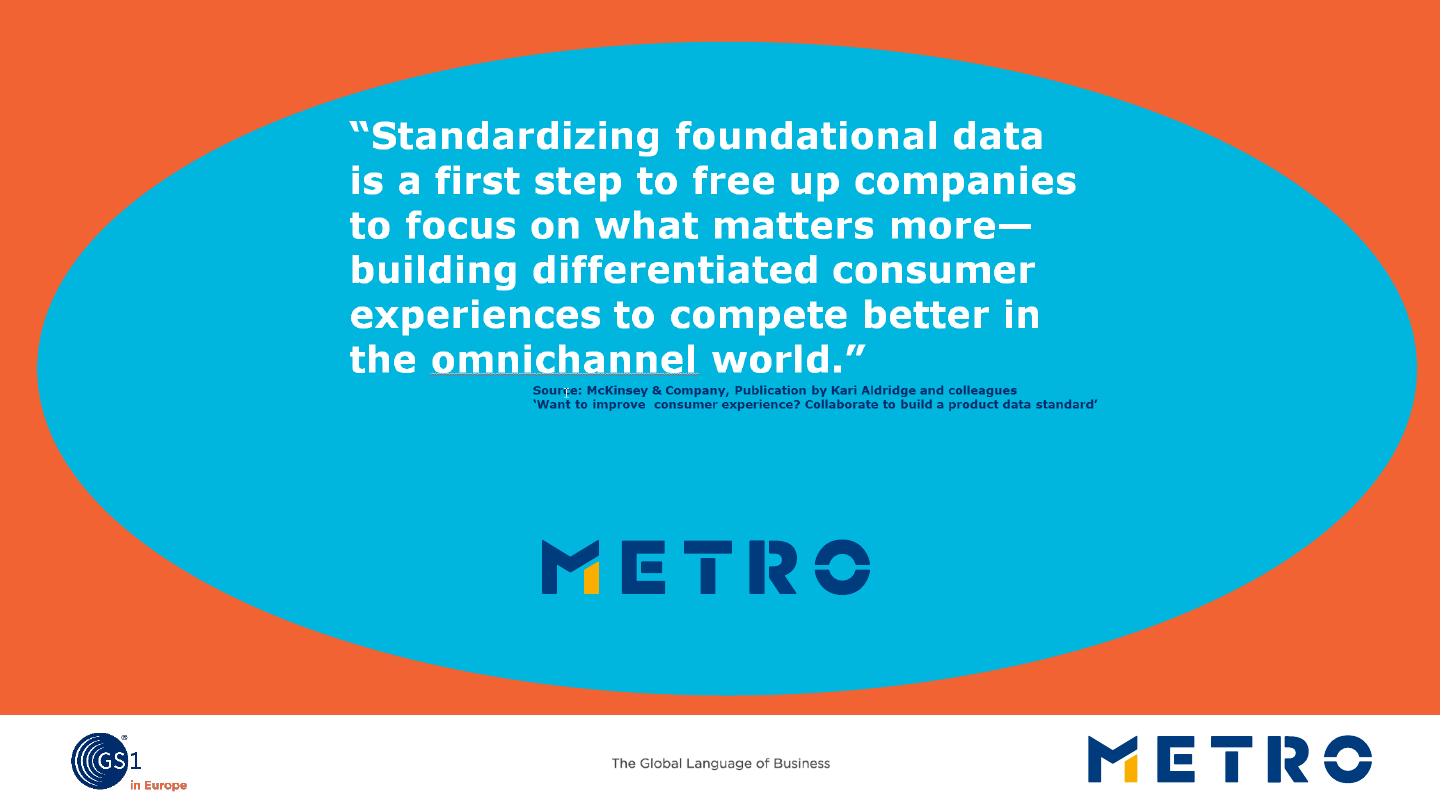
© GS1 in Europe 2020
92
Driving market adoption by
community enablement
• Inform
• Initialize national GDM project
• Onboard industry
• Setup local GDM maintenance group
• Educate & Train
• Integrate national layer – local attributes to GDM
• Start operational use of common data model based on GDM
• Announce local GDM maintenance group members representing
market within regional GDM maintenance group
• Collect feedback and identify improvement needs
Global Data Model
COMMON STANDARD for
in EVERY markt

© GS1 in Europe 2020
globaldata[email protected]
One product.
One experience.
Every channel.
Every country.

© GS1 in Europe 2020
Next steps & Closing
94
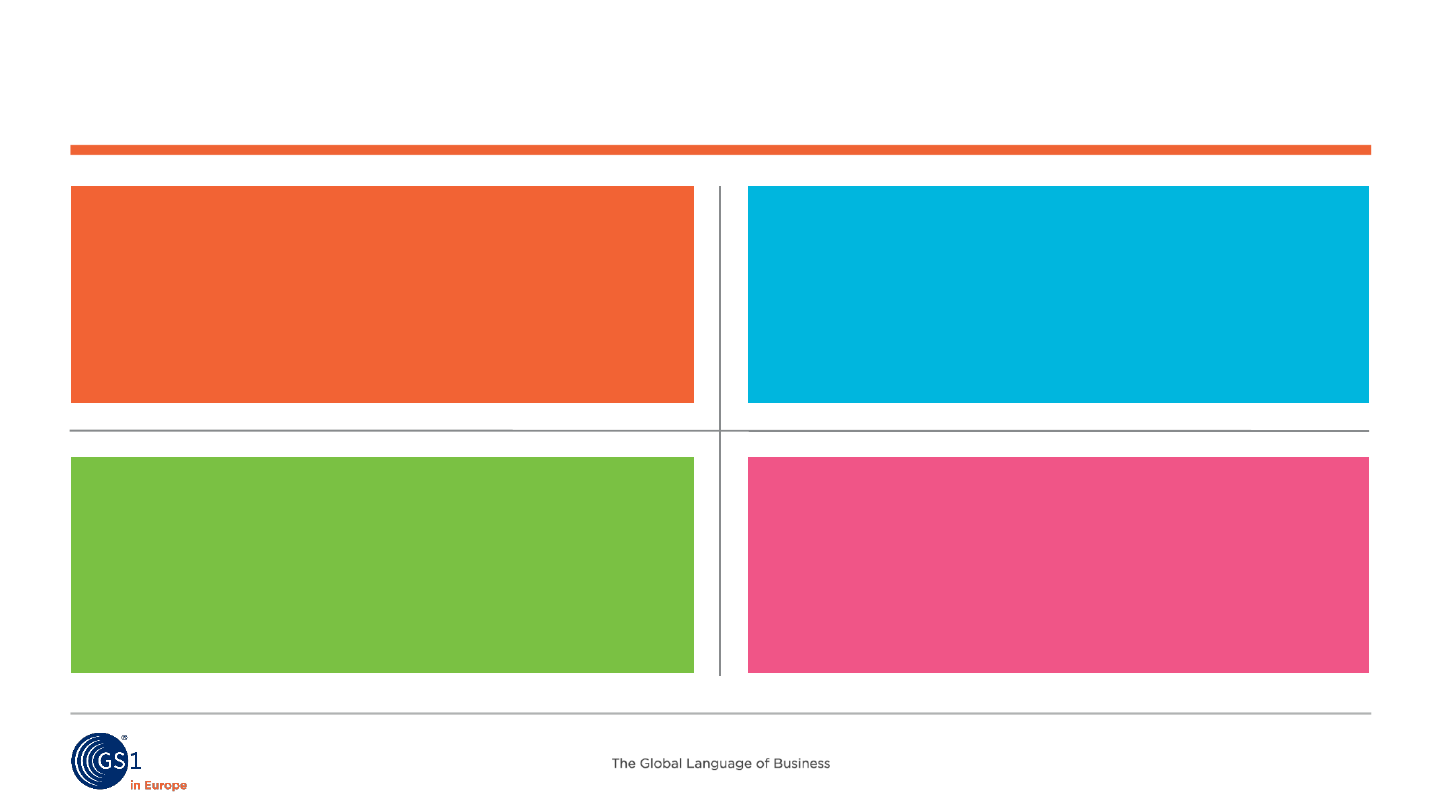
© GS1 in Europe 2020
Recap for Implementing the Global Data Model
95
Get organised and
connect with GS1
and ambassadors
Do the attribute gap
analysis and present
results
Implement global
and regional layers,
minimise local layer
Share local layer and
other findings with
global office

© GS1 in Europe 2020
Recap for Governance of the Global Data Model
96
Connect with GS1
and industry peers
Have a local
governance process
in place
Work on change
requests (add
/change/ remove)
Intention to submit
the local layer as a
standard

© GS1 in Europe 2020
Next steps
97
Survey on implementation of the Global Data Model in Europe
Connect with Industry Peers and GS1 => in local user groups
Work on the gap analysis of the global data model (industry & GS1)
Submit the local layers to the Interim GDM Navigator
Help to grow the community in the region: new industry & new target markets
Actively participate in regional governance

© GS1 in Europe 2020
Next meeting
98
END of AUGUST
Gap analysis results
Appoint co-chairs
First steps on further
harmonisation



